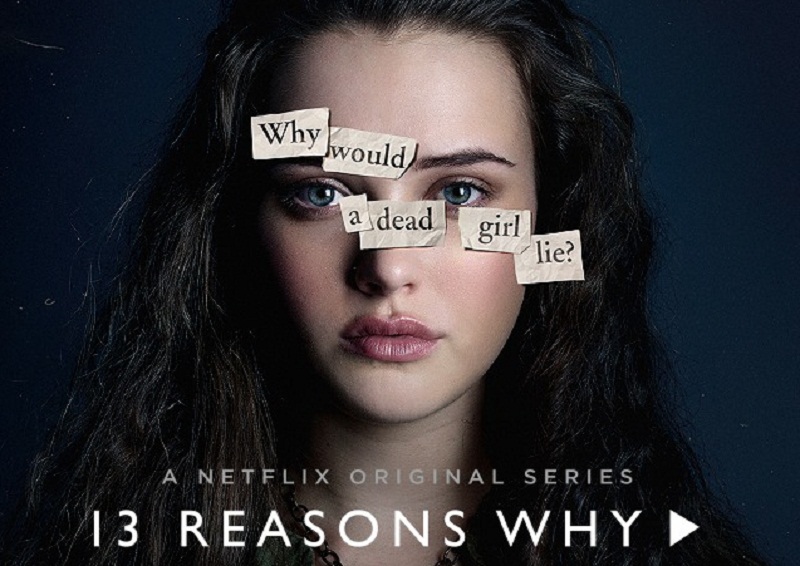13 Reasons Why: A Vengeful Suicide
Photo courtesy of Google Images
13 Reasons Why is a Netflix show based on the bestselling novel ‘Thirteen Reasons Why’ by Jay Asher.
The debut of the Netflix original series, “13 Reasons Why” on Mar. 31 of this year, made a notable impact on modern pop culture and catalyzed the formation of fandoms across the world. The series, directed by Kyle Patrick Alvarez, Gregg Araki, Carl Franklin, Tom McCarthy, Helen Shaver and Jessica Yu, is based off of the 2007 young adult novel of the same title written by Jay Asher.
The show reveals the inner thoughts and emotions of a teen who committed suicide from an angle that I have never seen before.
The series follows one of the main characters, suicide victim Hannah Baker, as she recounted the events leading to her carefully planned death. At the same time, the watchers gained insight on the life of a boy named Clay Jensen, one of 13 people who received Hannah’s ‘suicide note,’ a shoe box filled with 13 cassette tapes, each containing a reason, which correlates to the actions of a person in her life, that she blames for her suicide.
Hannah tasked all the people on her blame list with listening to all 13 reasons, then passing them on to the next person on the list. Clay’s tape was number 10, meaning that nine people received, listened to, and passed on the tapes before him. As he listened, the tapes revealed graphic and tragic images of the torments that Hannah experienced in her year and a half at the ironically named Liberty High School.
The producers and directors of the show did an impeccable job capturing the emotions present in every scene. As Hannah walked down the hallways of Liberty High, filled with shame and regret from the events that transpired the night before, the audience is practically placed in her shoes, feeling the hot scorn of her classmates glaring down on her.
The actors also gave the show a genuine sense of reality. Although I had never seen the horrid things that happened in this show transpire in real life, the actors brought just enough pettiness and emotional angst to the table to make the audience believe that this could plausibly occur in the halls of Cam High.
My main qualm with this show is not with the motives of the writers, as I believe they succeeded in achieving their goal of revealing the drama and dangers of bullying, as well as the realities of suicide. There are many benefits to informing society of what goes on behind closed doors and that is the praise I have for this series, besides the excellent quality of the directing and acting as I stated before. But for me, these positives are not enough to outweigh the negative that I believe can come from “13 Reasons Why.”
This show presents a real danger to suicidal teen viewers that cannot be overlooked for the sake of spreading a message, no matter how beneficial that message may be. “13 Reasons Why” blatantly romanticized suicide and painted it as a way to build a legacy after your death.
As a viewer who has not struggled with suicidal tendencies, after watching this show, I seriously took a step back, looked at all that was around me and realized how much power I could have over the individuals in my life with a slit of my wrist.
Now consider what someone contemplating suicide might think. I would assume they would have a similar opinion as me, but with their mental state, who is to say they wouldn’t take any action. For many of us, as beings who often desire attention from others and often seek recognition for our strongsuits, committing suicide and finally receiving the attention one lacked as a result of years of bullying and negativity presents a very real temptation.
Ijeoma Oluo, of theestablishment.co, watched the series with her son, who survived a suicide attempt a few years prior to seeing the show. “My son had just watched the ultimate fantasy of teen suicidal ideation,” Oluo wrote in her online blog. “He had watched an unhappy teenage girl kill herself, and in doing so, throw all of those who had harmed her into deep regret and shame while the ghost of Hannah got to say, ‘Why didn’t you do anything about this while I was alive?’ He watched suicide as successful revenge.”
This introduces another problem with the series. It sends the message that leaving behind a list of those who bear the guilt for one’s death is a “successful revenge.” This can lead to potential copycat suicides, committed by people hoping for the same degree of success that Hannah appeared to have with hers.
Those watching observed these people’s lives being devastated by Hannah’s tapes. In some cases, such as Hannah’s ex-friend Jessica, you could see a physical degradation as she became thinner and her face showed visible circles and bags around her eyes in the wake of Hannah’s legacy. This degradation of Hannah’s classmates was portrayed as a deserved and fitting revenge. Undoubtedly, the people who suffered did deserve consequences for their actions, but is it really wise to show viewers that causing them prolonged mental trauma is an adequate way to give them their due consequences? Wouldn’t it have been a less destructive and a generally more beneficial and didactic course of action to report them to authorities?
In an interview with USA Today, Harold S. Koplewicz, president of the Child Mind Institute, said that the show is dangerous for young viewers. “This program is coming into living rooms with attractive kids, who seem cool and with it, and are very witty, and they are giving the message of ‘once you are dead, you can get revenge on the people who were mean to you,’” he said.
Not only is the revenge aspect dangerous, but Koplewicz believes that the show could lead to copycat suicides in the future. “It’s not only the content, but the message it gives, which is that there is no help and that suicide is glamorous and effective,” he said. “It’s a false message, and it has a contagious effect.”
A message like this can be very tempting to those dealing with neglect from parents, friends, and teachers in their lives. While it is important to recognize that this opinion does exist among youth, the plot of the series justifies it in a way. It says that yes, your opinion that suicide is the only option is valid, and yes, you can go ahead with it.
Psychologist and executive director of Suicide Awareness Voices of Education, Dan Reidenberg, fears the uncanny ability of the show to pull viewers into the plot. In an interview with Syracuse.com, he said, “I hear kids all over saying, ‘The series portrayed my life.’” This is the danger according to Reidenberg. A huge pull in media, including TV shows, is relatablity. Everyone looks for ways to relate to their favorite characters, and if they are trying to relate to Hannah, then will they copy her decisions?
In light of all of this, Netflix has undoubtedly done a spectacular job in portraying a difficult and realistic situation.
The glorification of suicide is prevalent in this show. It is hidden behind a guise of suicide education and sympathy for the victims of bullying as well as other social pressures which in theory are good things. But none the less it is there and it has the potential to push people who are already at their breaking point over the edge. This is a risk we cannot afford to take.

Hello! My name is Annie and I am one of this year's co-managing editors. It is an honor to be a part of this news publication and I hope to help make it...

















































































![Senior Ditch Day... Relaxation or Truancy? [Video]](https://achsstinger.com/wp-content/uploads/2017/10/IMG_7119-900x599.jpg)
![Heavy Rain Hits Cam High [video]](https://achsstinger.com/wp-content/uploads/2017/02/maxresdefault-900x506.jpg)



